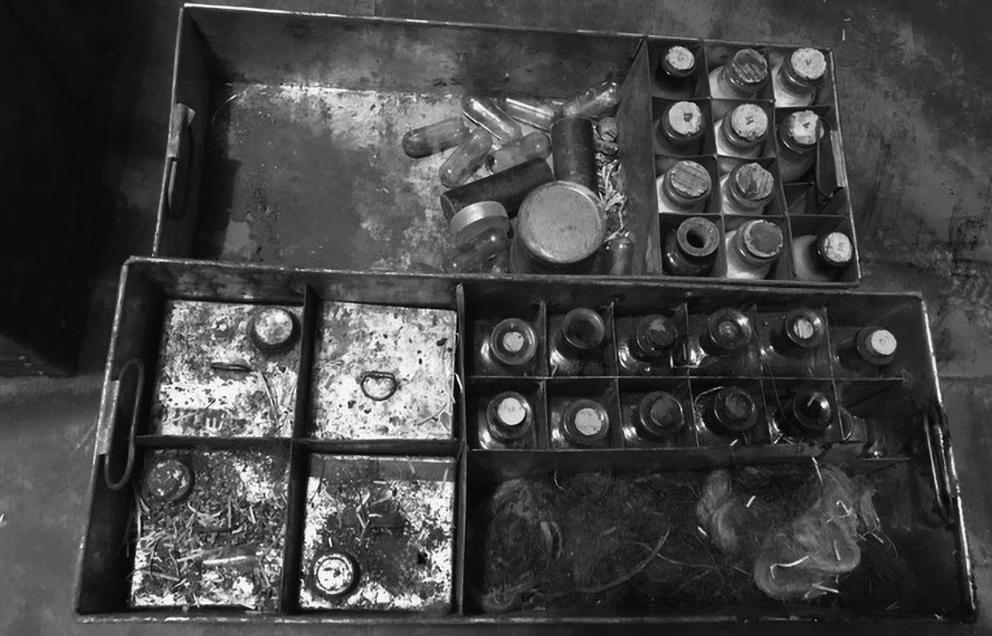You are here
Frontier Apothecary

For Matt, going to town represented a day’s ride from his job as a wrangler on a ranch along the Battle River, south of Castor, AB. His infrequent trips to Castor were always highlighted by a trip to Souch’s pharmacy. Matt savoured the merchandise and smells of frontier pharmacies: the mix of mint with a hint of Dustbane and hardwood oiled floors, and the aromas of apothecary ingredients like wintergreen, camphor and Tiger balm. Mr. Souch smoked cigars, and the smell of Havana leaf lingered along with the fragrance of the ladies perfume dispensary in one corner of the busy, yet organized, retail space. Matt marveled at the rows of apothecary jars in cabinets containing ingredients from laudanum, and calamine to Chincona bark and chalk for heartburn. Matt asked Mr. Souch for several bottles of liniment for his own aches and pains he encountered working the lonely life of a wrangler, and for tendon strains affecting his cow ponies. He took time to enjoy a soda from the soda fountain and write a letter home, which he would mail before heading back to fix fences and tend several hundred brood cows.
He stopped momentarily to glance at a display of Dingbat calendars and for a minute lost himself in the whimsical world of Dingbats. The appealing calendars, produced by Merck Frosst and artist William Dudley Burnett Ward, were distributed to medical clientele for nearly a century. Dingbat calendars disappeared in 1996, a result of the Canadian industry's association decision that the Dingbat promotion by Merck Frosst represented unfair competition.
Small towns proliferated across the prairies as thousands of settlers established homesteads, and railways inched across the frontier. During the turn of the century, business commenced on Main Street in many new towns with a “drug store” or apothecary, often located alongside a grocery and hardware store, and a post office. Just off the main drag, all towns had a livery stable and blacksmith shop. A good apothecary often preceded medical doctors and hospitals. Castor followed the pattern.
The words “pharmacy” and “apothecary” are often used interchangeably. Both are places where medication is prepared for use and dispensed. Historically, the word apothecary symbolized a profession rather than a place, per se. In medieval Europe, individuals selling wine, spices and herbs were known as apothecaries. Today, the word apothecary is generally reserved for the physical act of compounding medications and medicinal herbs.
In earlier times, the apothecary served more than a druggist in far-flung communities. They provided medical treatment, prescribed medicine, trained apprentices, performed surgery and served as manmidwives. The apothecary often practiced as doctors and acted as veterinarians. They stocked veterinary medicines and sold a wide range of general merchandise including tobacco, perfumes, cosmetics, spices and chemicals. The “drug store” became downtown social centres for many communities, especially if they had a soda fountain.
Drug control laws were generally non-existent, or largely unenforced, as the frontier expanded through the turn of the century. Society and law enforcement at the time expected the pharmacist to use their level of education and training to the extent they could, especially with respect to controlled drugs and opium derivatives. Prior to 1880, few formal schools of pharmacy existed. North American pharmacists usually learned by apprenticing for four years with experienced practitioners.
Through time, active ingredients were isolated from their crude, natural sources. As science and technology advanced, pure active principles could be synthesized to produce drugs with predictable activity. Though the pharmaceutical world changed radically and, with it, the way veterinary and human drugs were marketed, the local apothecary remained an important element in many communities.
Veterinary clinics and farm service centres inherited the role of servicing the livestock community, yet 2 mental memories linger with the smells of udder balm, oil of wintergreen and horse liniment emanated by the downtown apothecary.
Article written by Dr. Ron Clarke
